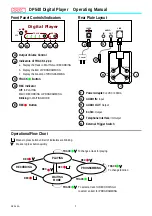
Comments
•
Strain measurements require the use of Bridge Completion Signal Conditioning
Plug-ons.
•
Bridge Completion SCPs provide the strain measurement bridges and their
excitation voltage sources.
<
ch_list
>
specifies the voltage sensing channels that
are to measure the bridge outputs. Measuring channels on a Bridge Completion
SCP only returns that SCP’s excitation source voltage.
•
The
<
range
>
parameter: The HP E1413 has five ranges: .0625 VDC, .25 VDC,
1 VDC, 4 VDC, and 16 VDC. To select a range, simply specify the range value
(for example, 4 selects the 4 VDC range). If you specify a value larger than one of
the first four ranges, the HP E1413 selects the next higher range (for example, 4.1
selects the 16 VDC range). Specifying a value larger than 16 generates Error -222,
“ Data out of range” . Specifying
0
selects the lowest range (.0625 VDC). Specifying
AUTO
selects autorange. The default range (no range parameter specified) is
autorange. Autorange is not allowed while
SENSe:FILTer:LPASs:STATe
is
ON
.
Error +3072, “ Autorange not allowed with SENSE:FILTER on” will be generated at
INITiate:IMMediate
time if the filter is
ON
and any channel specifies autorange.
<
range
>
may be specified in millivollts (mv).
•
If you are using amplifier SCPs, you should set them first and keep their settings
in mind when specifying a range setting. For instance, if your expected signal
voltage is to be approximately .1 VDC and the amplifier SCP for that channel has
a gain of 8, you must set
<
range
>
no lower than 1 VDC or an input out-of-range
condition will exist.
•
The channel calibration command (
*CAL?
) calibrates the excitation voltage source
on each Bridge Completion SCP.
•
Related Commands:
*CAL?
,
[SENSe:]STRain:
…
commands
•
*RST Condition:
SENSe:FUNCtion:VOLTage AUTO,(@100:163)
Usage
SENS:FUNC:STRain 1,(@100:,105,107)
[SENSe:]
242 HP E1313/E1413 Command Reference
Chapter 5
Artisan Technology Group - Quality Instrumentation ... Guaranteed | (888) 88-SOURCE | www.artisantg.com
















































